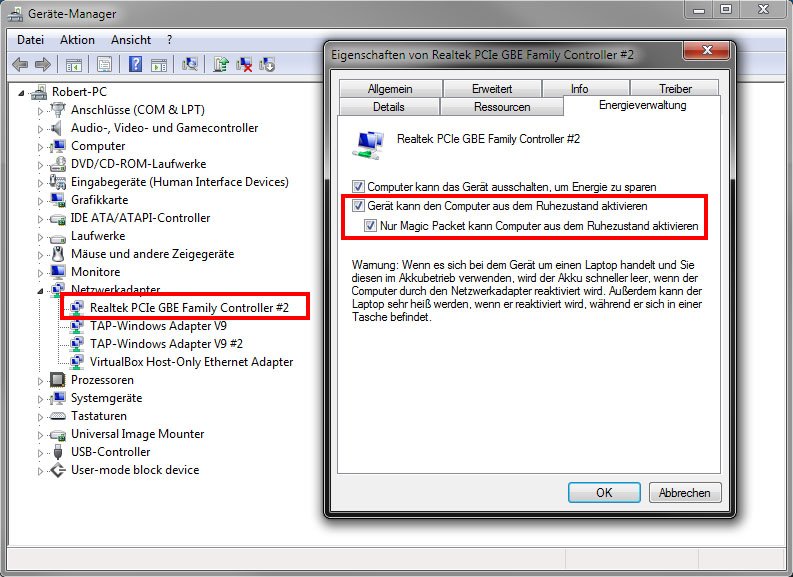

Wakeonlan windows Pc#
Turn off your PC while at home and test WOL to watch the PC turn on! Make one change at a time, and test each one from controlled scenarios as much as possible. When making changes to your network, you can’t be too thorough. The other tool I find invaluable for network troubleshooting is Ethereal, now known as Wireshark ( These three tools are freeware and easy to use. This comes in handy, allowing you to fire up the application, open your file, grab the MAC, and power up.
Wakeonlan windows mac#
I like the AMD Utility ( as it allows for creating and saving a file of target PC MAC addresses. I use two WOL utilities, mc-wol.exe, and AMD’s Magic Packet Utility. Private IP addresses are not transmitted across the Internet, and broadcasts are often blocked. The challenge at Layer 3 (which handles IP addresses) is transmitting a Layer 2 frame, destined for a private IP broadcast address, across the Internet. Typically, you’ll have a gateway router providing NAT (Network Address Translation) through the public IP address provided by your ISP. This guide assumes your LAN uses a private IP address space, such as 10.x.x.x, 172.16.x.x, or .x. For example, a gateway router with an IP address of 192.168.1.1 will typically have a broadcast address of 192.168.1.255. The broadcast address in most home and small business LANs ends in.255. Specifically, there is additional information carried in the header of a wireless frame that interferes with the magic packet frame, preventing the target machine from detecting the wakeup signal.Īt Layer 3, (the Network layer) WOL works best when directed at a broadcast address. Although both wired and wireless networks use MAC addressing, the format of a wireless frame is different than the format of a wired frame. It’s important to note that WOL doesn’t work over wireless networks. Your router will take the packet, strip the WAN IP, and send the packet to the Layer 2 MAC address on your LAN. A WOL packet sent over the Internet will hit your router first. The frame sent to the target PC carries a special datagram, called a “magic packet”, which triggers an Ethernet card (NIC) to power up a PC. IP addresses are loaded in memory, whereas MAC addresses are burned into the card. The MAC address is critical, as a PC in the off condition doesn’t have an IP address. (CCNA Intro Exam Certification Guide, Cisco Press, 2004, Wendell Odom, p34)Īt Layer 1, (the Physical layer) both the PC to be turned on and the PC sending the WOL signal need to use wired Ethernet connections.Īt Layer 2, (the Data Link layer) WOL uses MAC (Media Access Control) addresses to turn on a specific PC. As you can see in Figure 1, the OSI model specifies seven layers. To find your way through all the options, it’s helpful to reference the OSI model for computer networking. If you check your work at each step, you can avoid doing it all over again later. I have been involved in far too many network changes that had to be completely re-done due to poor testing and methodology. Trust me, you’ll thank yourself later for your patience and attention to detail now. I can’t emphasize enough the importance of making one change at a time, and then testing the effectiveness.


You’ll notice that testing comprises multiple steps in this guide. The goal here isn’t to cover every aspect of Wake On LAN/WAN technology, but to provide understanding and tools to make it work on your network. This guide lists those steps, covering BIOS configurations, software, testing, routing, and security. In order to take advantage of Wake On LAN/WAN technology, there are multiple steps to perform. Certainly, your PC is more secure from hackers when it is off. Maybe you saw Al Gore’s video, and you want to conserve energy and leave your PC off except when you need it. Perhaps you have a PC at home that you don’t want to leave powered on, yet may need to access while at work. Wake on WAN is the ability to send that same signal over a wide area network (WAN), such as the Internet, to trigger power-up of a PC on a private LAN. What is Wake On LAN? Wake on LAN, or WOL, is the ability to send a signal over a local area network (LAN) to power up a PC.


 0 kommentar(er)
0 kommentar(er)
